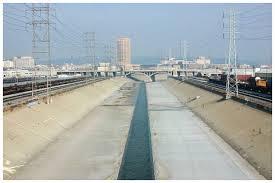Comparing two rivers: the Portneuf River and the Los Angeles River
Submitted by Eric Rude on Mon, 2015-06-08 00:00
I grew up in Los Angeles, so the "rivers" I was familiar with were the Los Angeles River (see attached picture) and Ballona Creek, both in huge concrete channels for most of their length, often with very little water flowing. So, when I moved to Pocatello, I was shocked to see the Portneuf River looking like a mini version of the LA River! And, when I started teaching, I was also shocked to find out how many people just accepted the Portneuf the way it was, considering it basically a "sewer" through town, and that they could do nothing about it. From 1991 to 2008, I got my students involved in Students Investigating Today's Environment (SITE), which was a state-wide river monitoring program (Matt Looze—weren't you part of that?). We tested the water quality every April and October, then discussed what could be done to fix some of the problems. Usually, we found very high numbers of fecal coliform, high turbidity, and high phosphate (and sometimes nitrates). Even though we weren't able to solve the Portneuf's problems, the students became more aware of the issues it faces.
I uploaded to youtube a video of the presentation I used to show my students. (One of my favorite facts here is about the numbers of rivers on Idaho's 303d list—how the state originally claimed there should only be 36!) Hope you find it interesting! (If anyone would like the original Keynote or Powerpoint presentation, we can figure out a way to get it to you.)
It's good to be looking at our river again!


Comments
Great Lesson!
What a great lesson! Great way to get the students aware of the problems we face with the portneuf.
DIGI PARTICIPATION
Dear Digis,
I have attached an excellent paper based on Eric's topic. I can't upload it here, but you can find it under the Teacher Resources tab. Look it over and let me know what you think...is environmentalism dead?
It can not be dead
It is up to us as educators to inspire children to become passionate about environmentalism. I realize that it is almost a bad word in certain political climates, but it is for the good of all of us and our future on this planet.
Let's play!
Thank you Eric for your post! I wonder if you might be interested in a partnership in which our students could share information with one another. My students study the Portneuf River every other year, and we share our water quality findings with the public at the Pocatello Environmental Fair. One thing that is hugely valuable is for "real science" to be shared with others, which is why I think our kids sharing information with each other could be a pretty great push for them to complete high quality work.
Sounds like a good idea!
Sounds like a good idea! Let's see what we can do. I'll have to dig out all of my old water testing kits and see what I still have. Which school are you at?
Partnership?
My students at PCCS study the health of the Portneuf this fall and also do water quality testing. It would be fantastic for us to have our kids share the information the collect with each other. I know that when my students know there is an outside audience and that their work will be seen by others, the quality of their work and the urgency to do high quality work is greatly increased.
SITE
The SITE program seems like it would be very interesting and something I would like to investigate further. Is there a website I can visit?
SITE
They don't have a website (that I know of). Back in 2008 or so, the SITE program ran out of funds, and I moved on to other things. I don't know if they got any funding back, or what their current status is, but I am trying to find out. I'll let you know if I hear anything!
Awesome
What an awesome way to get students involved and caring about their environment.
Portneuf
Aren't property rights one of the issues affecting the change of the look of the Portneuf River?